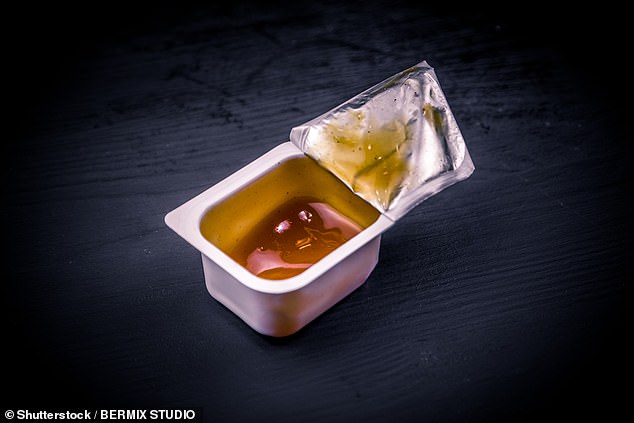Scientists find microplastics in disturbing new body part
Two new studies show that thousands of toxic chemicals enter our bodies through the packaging of everyday foods.
Swiss scientists have identified 3,601 toxic chemicals in products such as Tupperware, water bottles and canned food. These chemicals were found in human blood, urine, hair and breast milk.
The chemicals included Bisphenol A (BPA) and heavy metals which have been linked to cancer and reproductive problems.
Another team from Brazil made another surprising discovery. They discovered microplastics in a part of the nose that is connected to the brain. These microplastics may be linked to Alzheimer’s and Parkinson’s.
Thousands of potentially toxic chemicals have been found in the human body, new research has found. The chemicals were found to be seeping into food through their packaging
The substances enter food by coming into contact with the product through the packaging or by heating the food in the plastic take-away containers provided in restaurants.
“There are known hazardous chemicals that are known to have a negative impact on human health. These chemicals are leaching from packaging,” said Jane Muncke, co-author of the study and scientific director of the Food Packaging Forum.
There are 14,000 chemicals used in packaging, and a new study led by the Food Packaging Forum Foundation in Switzerland has found that 25 percent of them are “largely unregulated.”
“This is a staggering number and shows that food contact materials are a significant source of chemicals for humans,” said Martin Wagner, a professor of biology at the Norwegian University of Science and Technology in Trondheim. CNN.
‘The study is the first to systematically link the chemicals we use in the materials we use to package and process food and people’s exposure to them.’
The study, published in the Journal of Exposure Science and Environmental Epidemiologyreported that researchers found BPA in both food and the human body, where it was previously used in baby bottles, sippy cups and infant formula containers.
The chemical remained in the products until parents boycotted it more than a decade ago, but it is still found in other packaging today.
BPA has been linked to heart disease, erectile dysfunction, diabetes and cancer in adults. BPA has also been shown to increase the risk of premature death by 49 percent.
Heavy metals were also found in the products, which can be harmful to human DNA. They bind proteins and displace essential metal ions. These can change the way proteins function in the body and cause cell dysfunction.
They can become toxic as they gradually build up in the body, causing heart disease and cancer, disrupting brain development and lowering IQ in children.
A lesser known product are the small sauces that are popular in fast food restaurants.
The researchers noted that the small cups have a greater chance of contaminating food due to the short distance between the chemicals in the packaging and the produce

Food packaging such as small sauce pots can contaminate food, releasing dangerous chemicals into the body
Muncke said The Washington Post that she was on a plane recently and handed out a small container of salad dressing, which immediately raised doubts.
“They served the salad with a little plastic 15-ml bottle of olive oil and vinegar that you pour over it,” she said. “I thought, ‘Well, I’m not doing that.’
“We don’t think about the fact that (mostly) plastic packaging is adding chemicals to our food, but it’s a significant source of human exposure,” R. Thomas Zoeller, a professor emeritus of biology at the University of Massachusetts at Amherst who was not involved in the study, told The Post.
“This is an early indication that harmful chemicals, which are largely unregulated, are entering the human population.”
In addition to the toxic chemicals found throughout the body, a separate study also published this month found microplastics from water bottles in the olfactory bulb for the first time.
The olfactory bulb is a small piece of tissue in the nose that is separated from the nasal passage. Researchers have discovered that this bulb contains between five millimeters and one nanometer of plastic particles.
The study, published in the journal Environmental healthfound that the tissue could create a direct route for microplastics to enter the brain, although no published studies have confirmed the presence of PFAS in the brain.
According to the research team led by the University of São Paulo in Brazil, the microplastics could have reached the olfactory bulb through systemic circulation, through the respiratory tract or by crossing the blood-brain barrier.
Microplastics, or fragments of plastic smaller than five millimeters, are found in oceans, the air, food and even drinking water.
People are constantly inhaling and swallowing them, increasing the risk of whole-body inflammation, neurological effects, DNA damage, and a weakened immune response.
In total, 16 synthetic particles were found in eight of the fifteen deceased persons examined.
Polypropylene, a thermoplastic used in food packaging, was the most common polymer, accounting for 48 percent of the microplastics in the lamp.
These findings could pave the way for future research to understand where microplastics come from.
Philip Landrigan, MD, who was not involved in the study, said MedPage Today: ‘I think that in the coming years there will be much more information available about how microplastics enter the human body, and what they do next.’
